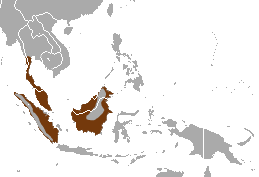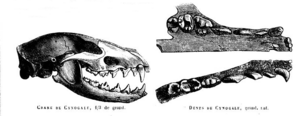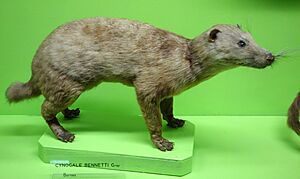Otter civet facts for kids
Quick facts for kids Otter civet |
|
|---|---|
 |
|
| Conservation status | |
| Scientific classification | |
| Genus: |
Cynogale
|
| Species: |
bennettii
|
 |
|
| Otter civet range | |
The otter civet (Cynogale bennettii) is a unique animal that lives partly in water and partly on land. It belongs to the viverrid family, which includes civets and genets. You can find these civets in countries like Thailand, Malaysia, Indonesia, and Brunei.
Sadly, the number of otter civets is going down a lot. This is mainly because their homes are being destroyed. Because of this, the IUCN Red List has listed them as an endangered species. This means they are at high risk of disappearing forever. The otter civet is the only species in its group, called a monospecific genus.
Contents
What Do Otter Civets Look Like?
Otter civets have special features that help them live in water. Their feet are webbed, just like a duck's, which helps them swim well. They also have long, stiff whiskers. These whiskers are very useful for finding food in the water, especially in the dark.
Where Do Otter Civets Live?
Otter civets live in parts of Sumatra, Borneo, and the southern part of Thailand. They seem to prefer living in lowland old-growth forests. However, they can also be found in forests that have grown back after being cut down. It's not clear if they live in northern Vietnam.
These animals especially like peat swamp forests. But they have also been seen in dry tropical forests at lower elevations.
In 2005, an otter civet was caught on camera in an acacia tree farm in central Sarawak. Later, between 2008 and 2009, ten otter civets were photographed in the Deramakot Forest Reserve in Sabah. This area is a lowland tropical rainforest in Borneo. In 2009, otter civets were seen for the first time in central Kalimantan. Two of them were photographed in the Sabangau Peat-swamp Forest.
How Do Otter Civets Live?
The otter civet is a nocturnal animal, meaning it is most active at night. They get most of their food from the water. Their diet includes fish, crabs, and freshwater mollusks like snails. They can also climb trees to eat birds and fruit. Because they are rare and very shy, we don't know much about them.
What Threats Do Otter Civets Face?
The biggest danger to otter civets is the destruction of their homes. Many peat swamp forests are being cleared to make room for oil palm plantations. This means the civets lose their natural habitat. Sometimes, they also get caught by accident in snares that were set for other animals.
How Are Otter Civets Protected?
The otter civet (Cynogale bennettii) is listed in CITES Appendix II. This means that trading these animals or their parts across borders is controlled. The goal is to make sure that international trade does not threaten their survival in the wild.




